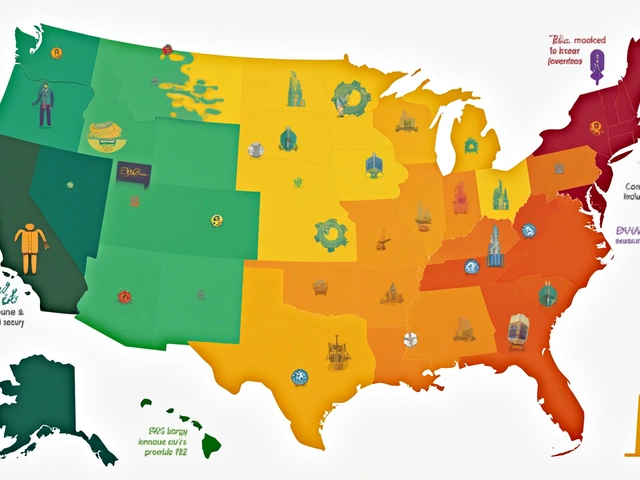People keep talking about dropshipping and online courses, but here’s the thing: more folks than ever want something they can actually hold. Local manufacturing businesses fill that gap. Forget huge warehouses or monster-sized investments—some of the most profitable small businesses right now run out of workshops or converted garages.
The key isn’t just making stuff, but making the right stuff. For example, niche products like eco-friendly packaging, custom furniture, or artisanal food items are exploding in demand. Many small shops report profit margins above 30% on these products, way ahead of old-school mass-produced goods.
Plus, if you keep production close to your customers, you can offer quick delivery and adapt fast if trends shift. That's a big win compared to waiting months on imports. Even better, customers these days like to support local makers—people feel good when they know who made their things.
- Why Small-Scale Manufacturing Is Booming
- Top Profitable Manufacturing Ideas for 2025
- Factors That Boost Profit Margins
- Common Mistakes and How to Dodge Them
- Getting Started Without Breaking the Bank
- Scaling Up: From Garage to Small Factory
Why Small-Scale Manufacturing Is Booming
Small manufacturing isn’t just keeping up—it’s sprinting ahead right now. Thanks to rising shipping costs, global supply chain headaches, and customers wanting stuff that feels special, profitable manufacturing at a smaller scale is taking off.
One of the biggest drivers is the shift away from mass-produced products. Remember when everything was made overseas and took weeks (sometimes months) to arrive? Now, people want fast delivery and are willing to pay extra for it. That’s easier to offer if you’re making products locally.
Hop onto social media and you’ll notice a flood of handmade or limited-run goods. Why? Because folks want unique, local creations instead of boring, one-size-fits-all stuff. Statistically, U.S. small manufacturers racked up $650 billion in sales last year, and nearly half of shoppers say they prefer “made near me” labels over imports.
| Reason | Impact |
|---|---|
| Shorter supply chains | Faster delivery, fewer delays |
| Personalized products | Higher prices, loyal customers |
| Support for local economies | Increased demand for small shops |
| Quicker trend response | Easy pivot for new products |
There’s also the tech upgrade. Simple 3D printers, laser cutters, and even AI-powered design tools are way more affordable—and easy to use—than a decade ago. This means you don’t need a massive factory to roll out cool new products.
Put it all together: less wait time, more control, higher profit margins, and a growing crowd of customers rooting for local businesses. That’s why small business owners are cashing in on profitable manufacturing like never before.
Top Profitable Manufacturing Ideas for 2025
When folks ask what profitable manufacturing looks like these days, you don’t have to look much further than products people need regularly, or that tap into growing trends. Right now, there are a few stars in the small business world you probably wouldn’t expect to be crushing it. Here’s what stands out for 2025:
- Eco-Friendly Packaging: More brands are desperate to stop using plastic. The demand for compostable containers, paper straws, and reusable bags is outpacing supply. Small manufacturers are locking in contracts with local restaurants and stores.
- Custom and Modular Furniture: With remote work still a thing, people are upgrading their home setups. Small shops that can build desks, standing tables, or modular shelves see high sales and strong margins—some hitting 40% profit when they sell direct.
- Gourmet & Artisanal Food Products: Think jerky, hot sauces, and craft snacks. Foodies want unique flavors and local products. If you've got a great recipe and a clean kitchen, you can start small and scale when orders increase.
- 3D Printed Parts and Prototyping: Local manufacturers making parts for drones, RC cars, or even machinery repairs are in high demand. A decent 3D printer and a knack for design can pay off fast—especially if you offer rush jobs.
- Health & Wellness Products: Natural soaps, aromatherapy candles, and simple supplements are seeing a surge. People want clean ingredients and local batches, not mass-market stuff from overseas.
Here's an at-a-glance look at how some of these small business manufacturing ideas stack up for potential:
| Product Niche | Estimated Startup Cost | Typical Profit Margin |
|---|---|---|
| Eco-Friendly Packaging | $8,000 - $18,000 | 20% - 35% |
| Custom Furniture | $5,000 - $22,000 | 30% - 45% |
| Artisanal Foods | $3,000 - $15,000 | 25% - 40% |
| 3D Printed Products | $2,500 - $10,000 | 35% - 50% |
| Wellness goods | $2,000 - $9,000 | 28% - 38% |
If you’re hunting for a side hustle or full-time gig, look at markets near you first. Check what your local stores don’t carry, or what businesses are importing. That kind of gap is often pure gold for a profitable manufacturing business in 2025.
Factors That Boost Profit Margins
If you want to actually make real money in a profitable manufacturing business, you have to focus on the stuff that makes margins fat, not just sales big. Here’s how the sharp folks do it:
- Niche Product Focus: Skip the generic stuff everyone else is making. The more unique or hard-to-find your product, the less you'll have to compete on price. Think small-batch soy candles, custom metal parts, or eco-friendly lunch boxes—customers pay extra for stuff that stands out.
- Keep Overheads Low: Rent eats profits. Lots of new small business owners start in their basement or garage, avoiding high fixed costs. Automation and simple tools can replace expensive labor early on, helping profits stick around.
- Local Sourcing: Buy raw materials from local suppliers and you’ll save on shipping, get better deals with quick cash payments, and cut down on delays. This can easily trim 5-10% off your costs compared to importing.
- Direct-to-Consumer Sales: Sell straight to your customer through your own website or social media. You dodge the middlemen and their cut, and you build a direct connection with peopled who buy from you—loyal customers come back more often and spend more.
- Lean Inventory: Too much stock ties up money and fills up space. Modern manufacturing business models use "just-in-time” production—make what you need, when you need it. Fewer leftovers and spoilage means extra cash in your pocket.
A 2024 review by the Small Business Administration showed companies using these strategies averaged a 28% net profit margin, compared to just 14% for those doing things old school.
| Strategy | Average Profit Margin Boost |
|---|---|
| Niche Focus | +8% |
| Direct Sales | +10% |
| Lean Inventory | +5% |
Bottom line? If you want your business ideas in manufacturing to actually pay off, don’t chase scale right away. Get creative about where you make, what you sell, and who you sell to. That’s the edge small shops have over big factories.

Common Mistakes and How to Dodge Them
Jumping into a profitable manufacturing business sounds easy, right? But plenty of folks get tripped up by some basic pitfalls, especially if they’re new to making and selling stuff. One mistake is overestimating demand. Just because you love something doesn’t mean everybody else will. Before buying any equipment or renting space, try selling samples to real customers or putting up a pre-order on a simple website. This lets you know if your idea actually has legs.
Another biggie: ignoring cash flow. In manufacturing, expenses don’t wait till you sell out. You’ve got materials, utilities, rent, and sometimes payroll. Lots of small businesses go under because they run out of money in month three—not because they had a bad idea, but because they didn’t keep enough cash on hand to stay afloat until sales picked up.
Miscalculating costs bites a ton of beginners. If you forget to add up little things—like shipping, returns, packaging, or machine maintenance—your margins get shredded fast. I’ve seen people set prices based only on what competitors post online, without knowing their own actual costs, and it ends ugly. Always keep a detailed spreadsheet, and update it every time your costs change, even by a little bit.
Here are a few classic mistakes (and better ways to handle them):
- Skipping local regulations: From fire codes to zoning, don’t assume you can make anything anywhere. Always check rules before signing a lease or starting production.
- Trying to do everything solo: Running a small business doesn’t mean you wear every hat. Outsource, partner, or just get some part-time help for stuff you’re bad at, like bookkeeping or marketing.
- Buying too much inventory up front: It’s tempting to get bulk discounts, but unsold stock eats up space and cash. Start small, reorder fast, and keep things moving.
- Falling in love with your own idea: Listen to feedback, especially the comments that sting. If customers keep telling you to tweak something—like size, color, or material—don’t ignore it.
Here’s a quick look at where new manufacturing businesses most often slip up, based on data from the Small Business Administration:
| Mistake Area | % of Failures |
|---|---|
| Poor Cash Flow | 33% |
| Misjudging Demand | 21% |
| Price Setting Errors | 18% |
| Regulation Issues | 12% |
| Other | 16% |
Dodging these mistakes is way easier when you slow down, check your numbers, get advice from others in the business, and keep your ego out of the way. The profit is real, but only for the folks who get the basics right.
Getting Started Without Breaking the Bank
Building a profitable manufacturing business doesn't mean you need a bucket of cash. It’s honestly easier than most people think to launch a small-scale manufacturing business in 2025—plenty of folks are starting with less than $10,000.
First step? Skip the fancy equipment. Start with simple tools or even second-hand machines that do the job. Check out local auctions, Facebook Marketplace, and company liquidations. For example, 3D printers for custom products now cost as little as $300, while laser cutters that used to be expensive are found for under $1,000.
If space is tight, use your garage or rent a small corner in a maker space—these places often let you use heavy tools by the hour. This slashes overhead so you're not bleeding cash before you ever make a sale.
- Pick products that don’t need huge upfront materials—like candles, handmade soaps, or printed T-shirts.
- Use digital tools to design and sell before you ever buy raw materials. Platforms like Etsy or even Instagram can help you judge interest first.
- Take advantage of small-batch suppliers for packaging and ingredients so you’re not forced to order huge amounts.
Small business grants are also out there. Local government programs and some banks will back new manufacturers, often favoring businesses using recycled or eco-friendly inputs. This is especially true if you’re in a region trying to boost local industry.
| Startup Item | Estimated Cost (USD) |
|---|---|
| Used 3D Printer | $300-$700 |
| Basic Laser Cutter | $800-$1,200 |
| Starter Inventory (Raw Materials) | $500-$1,500 |
| Basic Website | $100 |
| Legal/Permits | $200-$500 |
You don’t need to reinvent the wheel on your own. There are tons of free online guides, YouTube classes, and even local entrepreneur groups to help out. By staying focused, keeping costs low, and testing your idea first, you’ll be way ahead of most people who think you need a giant budget to get into profitable manufacturing.
Scaling Up: From Garage to Small Factory
Moving from a humble garage to a real small factory is a huge milestone. A lot of profitable manufacturing businesses have done just that—Apple literally started in a garage, and so did Amazon (yeah, seriously). Every big story starts somewhere small, but it doesn’t just happen by itself. You need to treat it as a step-by-step process.
First, you’ve got to know when you’ve outgrown your space. Signs? You can’t keep up with orders and you literally trip over supplies every day. If customer complaints about delays are piling up, it’s time.
- Get your numbers straight before anything else. Track monthly orders, profit margins, and equipment use. Don’t fly blind.
- Find a spot that fits your budget but leaves room to grow. Industrial parks and shared manufacturing spaces usually cost less than standalone buildings.
- Don’t go on a wild shopping spree for new machines. Start with what’s absolutely necessary and upgrade as cash flow picks up.
There’s real power in “lean manufacturing.” Stick to basics, avoid unused inventory, and keep overhead low. A Harvard Business Review article said,
"Small manufacturers that focus on lean production techniques scale twice as fast as those that expand too quickly."
Getting help can make a huge difference. Many local governments have grants or tax breaks for small manufacturers willing to set up in underused zones. Programs in the U.S. like the SBA 504 loan have helped thousands buy or renovate their first real workspace.
Staffing can be tricky. At first, it’s normal to do most things yourself or with family. Once you’ve got stable monthly sales and steady product making routines, hire one or two people to handle things that slow you down. That frees up your time for bigger tasks and lets you focus on getting more customers.
Let’s make this less abstract. Check this out—a snapshot from real 2024 data about spaces used by small manufacturers:
| Facility Type | Monthly Rent (US Avg) | Avg Production Space (sq ft) |
|---|---|---|
| Home Garage | $0–$200 | 200–500 |
| Shared Makerspace | $400–$800 | 800–1200 |
| Small Industrial Unit | $1,200–$2,000 | 1500–3000 |
Bottom line: Scaling up doesn’t mean you need millions. Focus on keeping what works, invest bit by bit, and pay close attention to what your customers actually want. That’s how backyard small business stories become so much bigger.






